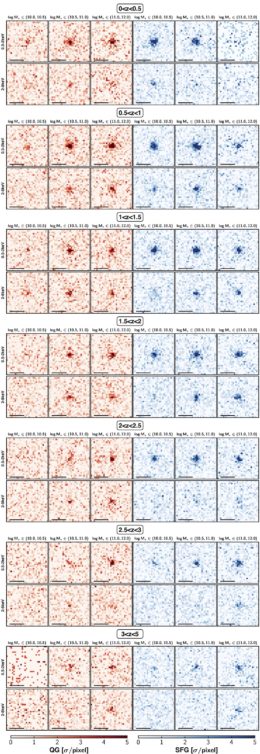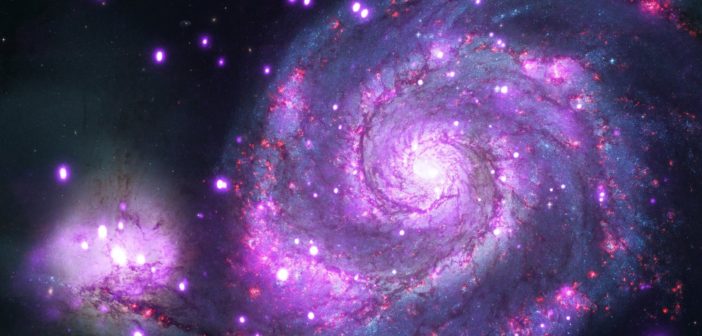Editor’s note: Astrobites is a graduate-student-run organization that digests astrophysical literature for undergraduate students. As part of the partnership between the AAS and astrobites, we occasionally repost astrobites content here at AAS Nova. We hope you enjoy this post from astrobites; the original can be viewed at astrobites.org.
Title: COSMOS2020: Ubiquitous AGN Activity of Massive Quiescent Galaxies at 0 < z < 5 Revealed by X-ray and Radio Stacking
Authors: Kei Ito et al.
First Author’s Institution: The Graduate University for Advanced Studies and National Astronomical Observatory of Japan
Status: Published in ApJ
While most passive or “dead” galaxies we see today have had fairly passive lives, distant passive galaxies in the early universe may have had a more active path to passivity. Detailed studies of nearby quiescent galaxies have revealed they follow a simple evolutionary track: a burst of star formation early on in their life followed by a quiet existence with low rates of star formation. In contrast, recent discoveries have uncovered a new population of quiescent galaxies that get quenched faster and earlier on than should be possible if following this simple evolutionary track (for example, the distant quiescent galaxies covered in this astrobite and that astrobite). The existence of so many quiescent galaxies so early on in the universe is a problem for galaxy evolution models, and the intense starburst phase and rapid suppression of star formation has been difficult to reproduce with cosmological simulations.
A big unresolved question related to this problem is how the burst of star formation gets suddenly shut off or quenched in these galaxies. Are the streams of gas from the cosmic web that fuel star formation getting cut off? Or is the gas flowing in and being expelled by some feedback mechanism? One such possible feedback mechanism is triggered by the galaxy’s central supermassive black hole as it funnels in material and creates a disk of hot, luminous gas and dust around it, forming an active galactic nucleus (AGN). The AGN devours some of the gas and radiation, wind, and jets eject the rest.
In today’s article, the authors leverage the extensive multiwavelength COSMOS2020 catalog to explore the AGN activity in quiescent galaxies across cosmic time through two primary AGN signatures: X-ray and radio emissions. However, many of these galaxies and the possible AGN within them, especially those farthest away, are faint enough that they are not individually detected in X-ray and radio surveys. To both overcome this faintness and to focus on typical (rather than extremely bright) sources, the authors use a technique called stacking to characterize the average properties of a quiescent galaxy sample and a comparison star-forming galaxy sample. Beyond comparing the stacks of quiescent galaxies and star-forming galaxies, the authors create a grid of stacks spanning stellar mass (basically, how big the galaxy is) and redshift (how far away and therefore how early on in the universe the galaxy is) to investigate trends along these axes.
Galaxy Pancakes
To better understand the stacking technique and the grid of stacks, imagine each galaxy is a pancake. Some pancakes are regular (quiescent) and the ones that have a little more going on are buttermilk (star-forming). Now let’s say all of the pancakes have berries in them, but eating a single pancake won’t get you a full serving of fruit. So, to portion out a daily fruit intake you make stacks of pancakes on each plate, separating out regular and buttermilk.
Besides the regular and buttermilk types of pancakes, let’s say they also come in different sizes, from silver dollar to the size of the plate — this represents the stellar mass axis. And of course, the pancakes weren’t made simultaneously: the stacks of pancakes made earlier are farther down the table from where you’re sitting, and the newer ones are right in front of you, similar to how more distant (i.e., higher redshift) galaxies represent conditions earlier in the universe than nearby galaxies.
To build their grid of galaxy pancake stacks, the authors used observations at wavelengths at which the galaxies were detected individually (optical and infrared) and redshifts from the COSMOS2020 catalog to decide which galaxies were star-forming versus quiescent as well as how massive each was. The authors then used observations at wavelengths at which the galaxies were not individually detected (X-ray and radio) to place stacked observations in a grid of stellar mass and redshift. The resulting sample is the largest, highest-redshift sample of typical quiescent galaxies created so far.
Taking an X-ray

Figure 1: The grid of galaxy stacks showing the average X-ray detection for two different X-ray bands. The red images show the regular pancake quiescent galaxies and the blue images show the buttermilk pancake star-forming galaxies, with redshift (z) increasing from top to bottom and stellar mass increasing from left to right in each color bin. Click to enlarge. [Ito et al. 2022]
Beyond identification of some general trends, physically interpreting these stacks requires understanding what is causing the X-ray emission. X-ray emission comes from two main sources in galaxies: X-ray binaries, which contain a dense stellar remnant energetically drawing material from a star in its orbit, and AGN. Returning to our analogy, the fruit content in the pancakes could come from whole berries scattered around the pancake (X-ray binaries) or from a berry jam filling in the center (AGN).
But if you only know the average amount of fruit in each pancake stack, how can you tell if it’s in the form of whole berries or a jam filling? Based on known relations between the star formation rate and stellar mass in a galaxy and the amount of X-ray binaries expected, the authors determined the relative contribution from X-ray binaries and AGN. With these models, they found that X-ray binaries could explain most of the X-ray emission for the star-forming galaxy stacks. On the other hand, for quiescent galaxies, the average X-ray emission in each stack was 5–50 times higher than expected from just X-ray binaries, implying that much of the X-ray emission came from AGN. Additionally, they found the biggest difference between the star-forming and quiescent samples in the highest redshift bin, providing hints that AGN may have a role in quenching star formation early in the universe.
Tuning In to the Radio
To further verify their findings, the authors then stacked data from the other major signature of AGN: radio emission. Similar to X-rays, radio emission comes from two main sources in galaxies: one related to ongoing star formation and one related to AGN. Taking an empirically known correlation between star formation rate and radio luminosity, the authors determined that the quiescent galaxy stacks have 3–10 times higher radio emission than expected from just star formation, while the star-forming galaxy stacks could be explained primarily by star formation. Consistent with the X-ray result, this suggests that faint AGN are ubiquitous in quiescent galaxies.
How to Quench a Pancake
How does this AGN feedback mechanism work to quench galaxies? In nearby galaxies, we know that quenching tends to occur with more active AGN. This is due to two processes: quasar-mode feedback and radio-mode feedback. In quasar-mode feedback, wind from a bright AGN expels gas from the galaxy and suppresses star formation. In radio-mode feedback, a typically fainter AGN heats the gas in and around the galaxy with radio jets, which prevents gas from cooling and forming stars. In this way, radio-mode feedback maintains quiescence rather than just reducing the possible star formation by tossing out fuel. The authors note their faint, typical sample is probably mostly undergoing radio-mode feedback, with some non-AGN environmental quenching coming into play at lower redshifts.
So what do these stacks tell us about galaxy evolution? The ubiquitous AGN signatures in both X-ray and radio give us an interesting clue about quenching: everyday quiescent galaxy pancakes are often filled with AGN berry jam, and feedback from faint AGN within them are likely the culprit for shutting off star-forming buttermilk berry galaxy pancakes so suddenly and early in the universe.
Original astrobite edited by Alice Curtin.
About the author, Olivia Cooper:
I’m a second-year grad student at UT Austin studying the obscured early universe, specifically the formation and evolution of dusty star-forming galaxies. In undergrad at Smith College, I studied astrophysics and climate change communication. Besides doing science with pretty pictures of distant galaxies, I also like driving to the middle of nowhere to take pretty pictures of our own galaxy!
